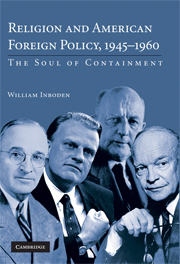2 - Unity Dissolved: Protestants and Foreign Policy, 1953–1960
Published online by Cambridge University Press: 31 July 2009
Summary
The year 1953 witnessed a growing paradox in the knotty relationship between religion and politics. On the one hand, America inaugurated a new president who presided over perhaps the greatest flowering of civil religion in the nation's history. Protestant, Catholic, and Jew were all urged to unite under the banner of “God and country,” as President Dwight Eisenhower and his Administration sought to create a new ecumenism that did not just transcend but actually erased old sectarian boundaries. On the other hand, many of America's religious leaders, particularly within Protestantism, grew more divided than ever on fundamental matters of faith and practice. While the political leadership sought to create religious and political unity, the religious leadership only deepened its religious and political discord. For the Protestant combatants fighting in the theological trenches, the pacific and prosperous 1950s were anything but.
Robert Wuthnow has described the religious convulsions of the postwar years as the “restructuring” of American religion. Traditional denominational distinctions – Methodist, Baptist, Presbyterian, Episcopalian – became less and less meaningful, as religion in America fractured not along denominational lines, but across them. Theological conservatives of several denominational flavors began to ally together in neo-evangelicalism and in reform movements within their various communions. Along the way, they often discovered that they shared conservative political convictions as well, coupled with an aversion to the political liberalism of their denominational hierarchies.
- Type
- Chapter
- Information
- Religion and American Foreign Policy, 1945–1960The Soul of Containment, pp. 63 - 102Publisher: Cambridge University PressPrint publication year: 2008

